8.1 Newton’s Laws of Motion and their Application in Sports
Multiple Choice Questions
According to Newton’s Second Law of Motion, the greater the movement of an object, the (CBSE TBQ)
(a) The longer distance will it travel
(b) Stronger will it resist the external forces
(c) Speedier it will cover the given distance
(d) More stable will it remain in its motion.
Newton’s First Law of Motion is known as the (CBSE TBQ)
(a) Law of Reaction
(b) Law of Inertia
(c) Law of Effect
(d) Law of Momentum
Newton’s Second Law of Motion is also known as (CBSE TBQ)
(a) Law of Reaction
(b) Law of Inertia
(c) Law of Momentum
(d) Law of Effect
Acceleration due to an external force acting on a moving object is technically defined as the change in that object’s (CBSE TBQ)
(a) Location
(b) Direction
(c) Velocity
(d) Movement
Bio-mechanics helps in which of the following ? (8.) (CBSE 2020)
(a) In improving technique
(b) In improving designs of sports equipment
(c) In improving performance
(d) All of these
The Law of acceleration is also known as (8.1) (CBSE 2020)
(a) Law of inertia
(b) Law of action and reaction
(c) Law of momentum
(d) Boyle’s law
Newton’s First Law of Motion is also known as (8.1) (CBSE 2020, Comptt.)
(a) Law of Inertia
(b) Law of Acceleration
(c) Law of Action and Reaction
(d) Law of Learning
Who gave laws of motion? (8.1) (SQP Term-I, 2021-22)
(a) Galileo
(b) Pascal
(c) Newton
(d) Darwin
Which law amongst the given ones is known as the first law of motion? (8.1) (SQP Term-I, 2021-22)
(a) Law of inertia
(b) Law of reaction
(c) Law of momentum
(d) Law of acceleration
Physical education teacher of ABC school was teaching the students about Newton’s Laws of Motion. While explaining he showed the students this picture and tried to explain how there is a difference in the speed of an object due to their weight. Can you name the law? (8.1) (SQP Term-I, 2021-22)

(a) Newton’s First Law of Motion
(b) Newton’s Second Law of Motion
(c) Newton’s Third Law of Motion
(d) Action Reaction
Rishi who was studying in class XII is a science stream student. During his Physical Education class, he got confused how Newton’s laws of motion are useful in sports and how they can be applied in sports. But his teacher explained these laws with help of examples from sports which proved to be very helpful for him swimming is the best example of which law of motion? (8.1) (SQP Term-I, 2021-22)
(a) Law of inertia
(b) Law of acceleration
(c) Law of reaction
(d) Both (a) and (c)
Starting a throwing event in athletics is an example of which law of motion. (8.1) (SQP Term-I, 2021-22)
(a) First law of motion
(b) Second law of motion
(c) Third law of motion
(d) First and third law of motion
In Law of Acceleration, acceleration of an object is inversely proportionate to its __________. (8.1) (SQP 2022-23)
(a) Force
(b) Mass
(c) Speed
(d) Size
Very Short Answer Type Questions (1 Mark)
Which field of study in sports is called ‘Biomechanics’? (8.0) (CBSE 2018)
Ans. Biomechanics is the study of internal and external forces and their effects on living system or athlete.
What do you mean by ‘Kinesiology’? (8.0) (CBSE 2018, Delhi)
Ans. • Kinesiology is the branch of physiology that studies mechanics and anatomy in relation to movement
• Is Science dealing with inter relationship of physiological process and anatomy of human body with respect to movement. (Any one)
What do you understand by linear movement ? (8.0) (CBSE 2015)
Ans. Linear movement refers to motion that occurs in a straight line, with the object or body moving from one point to another in a straight path.
Name one linear and one angular movement from the field of sports. (8.1) (SQP 2016-17)
Ans. One linear movement in the field of sports is running in a straight line. One angular movement is swinging a golf club.
What is aerodynamics ? (8.1) (SQP 2017-18)
Ans. Aerodynamic is related to the flow of air around a projectile, which can influence the speed and direction of the object. The four forces of flight are lift, gravity, thrust and drag. These forces make an object move up and down, and faster and slower.
Short Answer Type-I Questions (2/3 Marks)
List Newton’s Laws of Motion. (CBSE TBQ)
Ans. Newton’s Laws of Motion are as follows :
- Newton’s First Law of Motion : An object at rest will stay at rest, and an object in motion will stay in motion with the same speed and in the same direction, unless acted upon by an external force.
- Newton’s Second Law of Motion : The acceleration of an object is directly proportional to the net force acting on it and inversely proportional to its mass.
- Newton’s Third Law of Motion : For every action, there is an equal and opposite reaction.
Elucidate Newton’s Law of Inertia. (CBSE TBQ)
Ans.
- Newton’s First Law of Motion, also known as the Law of Inertia, states that an object will remain at rest or continue to move at a constant velocity unless acted upon by an external force.
- In other words, an object will resist any change in its motion.
- This law is based on the concept of inertia, which is the tendency of an object to resist changes in its state of motion.
With suitable examples explain the application of Newton’s law in sports. (8.1) (CBSE 2020)
Ans. Newton’s laws of motion have various applications in sports.
- First Law of Motion : This law can be seen in activities like running, where a sprinter needs to exert force to overcome inertia and start moving.
- Second Law of Motion : This law can be observed in activities like throwing a javelin or shot put.
- Third Law of Motion : This law can be seen in activities like swimming, where a swimmer pushes against the water to move forward, and the water exerts an equal and opposite force, propelling the swimmer forward.
- Friction : Friction plays a crucial role in activities like running, where the friction between the athlete’s shoes and the ground allows them to push off and move forward.
- Projectile Motion : In sports like basketball, soccer, or cricket, players use projectile motion to accurately pass, shoot, or hit the ball towards a target.
- Levers : Levers are used in activities like weightlifting, where the athlete uses their body as a lever to lift heavy weights.
Short Answer Type-II Questions (4 Marks)
With the help of suitable examples, discuss the application of Newton’s Laws of Motion in sports. (CBSE TBQ)
Ans. Some examples of how Newton’s laws of motion are applied in sports include :
- When a ball is thrown, kicked, or struck with an implement, it tends to travel in the direction of the line of action of the applied force. The greater the amount of force applied, the greater the speed the ball has.
- A skater gliding on ice will continue gliding with the same speed and in the same direction unless an external force acts upon the skater.
- The force applied to the ball is matched with an equal and opposite force applied to the racket.
- In swimming, a diver needs to push down on the springboard when diving off a diving board. The springboard pushes back with an equal and opposite force for proper projection into the air during the performance.
- In soccer, a team will require more force to kick the ball high and faster. This law of motion is fundamental in soccer, as it allows players to calculate the force needed to give a pass or kick the ball to the net without missing.
How can Newton’s second law and third law of motion be applied in sports ? (CBSE TBQ)
Ans. Newton’s Second Law :
- This law states that an object will remain at rest or in uniform motion unless acted upon by an external force.
- In sports, this law can be seen in activities like running, where athletes need to exert a force to overcome their inertia and accelerate.
- For example, a sprinter pushing off the starting blocks to gain momentum.
- In sports like gymnastics, the law of inertia is evident when a gymnast performs a somersault or a flip.
- The gymnast’s body resists changes in motion due to its inertia, allowing them to rotate in the air.
Newton’s Third Law :
- This law states that for every action, there is an equal and opposite reaction.
- In sports, this law can be observed in activities like swimming, where a swimmer pushes against the water with their arms and legs to propel themselves forward.
- The water exerts an equal and opposite force, pushing the swimmer in the opposite direction.
- When a player kicks the ball, they exert a force on the ball, causing it to move.
- Simultaneously, the ball exerts an equal and opposite force on the player’s foot, providing stability and balance.
Long Answer Type Question (5 Marks)
Why the knowledge of biomechanics is essential for a coach to overcome the limitations of physical strength of an athlete? (8.1) (SQP 2016-17)
Ans.
- The knowledge of biomechanics is essential for a coach to overcome the limitations of physical strength of an athlete because it allows them to understand how the body moves and functions during athletic performance.
- By understanding the biomechanics of a particular sport or movement, a coach can identify any inefficiencies or limitations in an athlete’s technique and make adjustments to optimize their performance.
- For example, if an athlete lacks physical strength in a certain area, such as their legs, a coach with knowledge of biomechanics can analyze their movement patterns and identify ways to improve efficiency and maximize the use of their available strength.
- This could involve adjusting their body positioning, modifying their technique, or implementing specific training exercises to target and strengthen the weak areas.
- Additionally, biomechanics can help a coach prevent injuries by identifying potential risk factors and implementing strategies to minimize them.
- By understanding the forces and stresses placed on the body during athletic movements, a coach can teach proper technique and provide guidance on injury prevention strategies, such as proper warm-up and cool-down routines, stretching exercises, and equipment selection.
- Overall, the knowledge of biomechanics allows a coach to optimize an athlete’s performance by understanding how to overcome the limitations of their physical strength through proper technique, training, and injury prevention strategies.
Case Study Questions (4 Marks)
1. NEWTON’S SECOND LAW OF MOTION : As per the law, the rate of change of momentum is proportional to the resultant force and takes place in the direction of the resultant force. When a net force acts on an object, the acceleration of the object it produces is directly proportional to the magnitude of the net force, is in the same direction as the net force and inversely proportional to the mass of the object. The more mass the thing has, the more net force has to be used to move it.
In general, if you use the same force to push a truck and push a car, the car will have more acceleration than the truck because the car has less mass
What
)
Ans. –
2. NEWTON’S THIRD LAW : According to this law, there is an equal and opposite reaction for every action, and this reaction acts with the same Momentum and the opposite velocity for every action. It states that whenever one object exerts a force on a second object, the second object exerts an equal and opposite force on the first object. When you walk
on a floor, the floor pushes you along.
What
)
Ans. –
8.2 Levers
Multiple Choice Questions
The three basic components of a lever are (CBSE TBQ)
(a) Mass, Weight and Velocity
(b) Force, Fulcrum and Load
(c) Fulcrum, Resistance and Effort
(d) Both (b) and (c)
What type of lever is depicted in the picture? (CBSE TBQ)
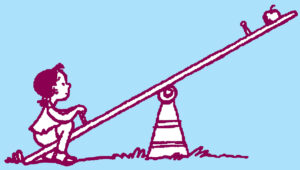
(a) 1st Class lever
(b) 2nd Class lever
(c) 3rd Class lever
(d) None of the above
Push up is an example of which lever? (CBSE TBQ)
(a) Law of Reaction
(b) Law of Inertia
(c) Resultant Force
(d) Law of Effect
In the human body, the most common class of lever ________. (CBSE TBQ)
(a) 1st Class lever
(b) 2nd Class lever
(c) 3rd Class lever
(d) None of the above
When the angle between the two bones decreases it is termed as __________. (8.2) (SQP 2019-20)
(a) Flexion
(b) Extension
(c) Abduction
(d) Adduction
Identify the movement : (8.2) (SQP Term-I, 2021-22)
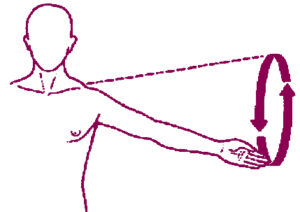
(a) Rotation
(b) Circumduction
(c) Flexion
(d) Extension
Sohan, a new student in the school, was very much interested in sports and while learning various biomechanical aspects of the game including various movements he became curious to understand movements used in different games. (8.2)
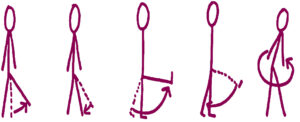
Flexion and extension comes under which movement. (SQP Term-I, 2021-22)
(a) gliding
(b) angular
(c) rotation
(d) circumduction
Which action is shown in the illustration? (8.2) (SQP Term-I, 2021-22)
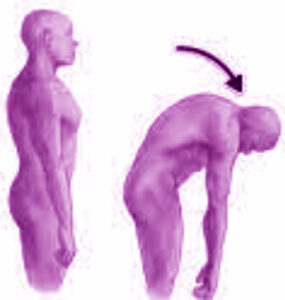
(a) Flexion
(b) Extension
(c) Adduction
(d) Abduction
Which movement is caused by moving a body part away from
the medial line of the body? (8.2) (SQP Term-I, 2021-22)
(a) Flexion
(b) Extension
(c) Adduction
(d) Abduction
Match the Column :
Match the movements : (8.2) (SQP Term-I, 2021-22)
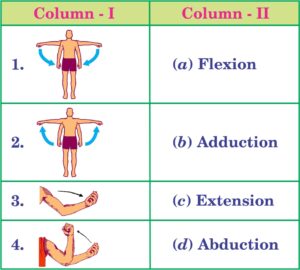
(a) 3 2 1 4
(b) 2 3 1 4
(c) 4 2 3 1
(d) 4 1 3 2
Very Short Answer Type Question (1 Mark)
What do you mean by flexion and extension ? (8.2) (CBSE 2019, Comptt.)
Ans. Flexion : Flexion refers to the movement that decreases the angle between two body parts.
Extension : Extension refers to the movement that increases the angle between two body parts.
Short Answer Type-I Questions (2/3 Marks)
Define lever. (CBSE TBQ)
Ans. A lever is “a rigid bar used to overcome resistance when a force is applied.” It is a rigid piece that transmits and modifies force or motion when forces are applied at two points, and it turns about a third point called the fulcrum.
Draw three types of levers used in sports. (CBSE TBQ)
Ans. First-Class Lever :
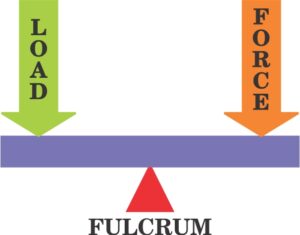
Second-Class Lever :

Third-Class Lever :
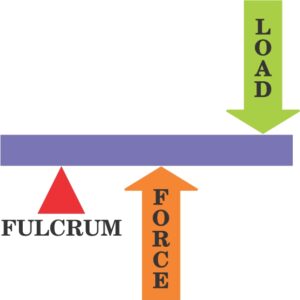
What is the relationship between load and adaptation during training programme ? (8.2) (SQP 2016-17)
Ans. –
- Load plays a crucial role in adaptation during a training program.
- The load refers to the amount of stress or resistance placed on the body during exercise.
- During a training program, gradually increasing the load over time is important for continued adaptation.
- The specific adaptations that occur depend on the type of training and the load applied.
- However, it’s important to note that the load must be carefully managed to avoid overtraining or injury.
- On the other hand, too little load may not provide enough stimulus for adaptation.
Short Answer Type-II Question (4 Marks)
With the help of suitable examples, discuss the application of 1st class lever in sports. (CBSE TBQ)
Ans. Yes, examples of the application of a first-class lever in sports include :
- Tennis serve : When a tennis player serves the ball, the lever is formed by the arm and the racket. The fulcrum is the shoulder joint, the effort is applied by the muscles in the arm, and the load is the weight of the racket and the force applied to hit the ball.
- Diving : In diving, the lever is formed by the body and the board. The fulcrum is the point where the diver’s feet touch the board, the effort is applied by the muscles in the legs, and the load is the weight of the diver’s body.
- Gymnastics : In gymnastics, various skills such as flips and somersaults involve the use of first-class levers. The fulcrum is the joint where the movement is initiated, the effort is applied by the muscles, and the load is the weight of the body.
What do you mean by lever? Explain with the help of diagrams. (CBSE TBQ)
Ans. A lever is a simple machine that consists of a rigid bar that rotates around a fixed point called the fulcrum. It is used to overcome resistance or move objects by applying force at one end of the bar. There are three types of levers :
- First-Class Lever : The fulcrum is located between the effort and the load. Examples of first-class levers in sports include a seesaw and the movement of the head on the neck joint.

- Second-Class Lever : The load is located between the fulcrum and the effort. Examples of second-class levers in sports include a wheelbarrow and the movement of the foot during plantar flexion.

- Third-Class Lever : The effort is located between the fulcrum and the load. Examples of third-class levers in sports include the movement of the bicep during flexion at the elbow and the movement of the quadriceps during kicking.

Case Study Questions (4 Marks)
1. LEVERS : The lever is a type of machine. It is the human body’s mechanism for movement, and although it may be viewed as a part of the skeletal system, the role of the muscles in supplying the necessary force for lever action should be kept in mind. The bony levers will be less stationary until they are moved by the muscles, which are motionless until the nervous system stimulates them.
All lever systems are made up of four components :
- the load
- the fulcrum
- the effort
- the lever
The load is the object requiring moving, the effort is the muscular force we use to move the object, the fulcrum is the joint around which the movement occurs, and the bones of the skeleton are the levers.
What
)
Ans. –
2. TYPES OF LEVERS : First-Class Lever : A first lever has the fulcrum between the force and the resistance. This class fulcrum may be moved about along the lever, thereby changing the relative lengths of the force arm and the resistance arm. If the fulcrum is placed close to the resistance, the force arm is length, and hand and less force need to be applied to move the resistance, but force must be applied through a long distance to lift the resistance a short distance.
Second Class Lever : A second class lever has the load resistance between the fulcrum and the force. In this class of levers, movement of the fulcrum will increase or decrease both the force arm and the resistance arm. The force arm is always the longer of the two, and therefore the force needed to lift resisting weight will always be less than the weight.
Third Class Lever : A third-class lever has the force between the fulcrum and the resistance. In this class of lever, the force arm is always shorter than the resistance arm, and so a large amount of force must be applied, but the resistance is moved through a much longer range of motion than the force application. In the human body, the most common class of lever is the thread.
What
)
Ans. –
3. APPLICATION IN SPORTS : The human leverage system is built for speed & range of movement at the expense of force. Short force arms & long resistance arms require great muscular strength to move like biceps & triceps attachments biceps force arm is 1 to 2 inches triceps force arm less than 1 inch. Human leverage for sports skills requires several levers; throwing a ball involves levers at the shoulder, elbow & wrist joints. The longer the lever, the more effective it is in imparting velocity. A tennis player can hit a tennis ball harder with a straight-arm drive than with a bent elbow because the lever is longer & moves at a faster speed. Long levers produce more linear force and thus better performance in some sports such as baseball, hockey, golf, field hockey, etc. For quickness, it is desirable to have a short lever arm baseball catcher brings his hand back to his ear to secure a quick throw sprinter shortens his knee lever through flexion that almost catches his spikes in his gluteal muscles.
What
)
Ans. –
8.3 Equilibrium (Stability/Balance)
Multiple Choice Questions
When the sum of force acting upon the object and sum of the movement acting upon the body is both equal to zero then the body is said to be in (CBSE TBQ)
(a) Equilibrium
(b) Static equilibrium
(c) Dynamic equilibrium
(d) Zero force
The position of the centre of gravity changes depending upon the (CBSE TBQ)
(a) position of force
(b) position of the body
(c) position of the intersection of force
(d) position of stability
Centre of gravity is the average location of an object’s (CBSE TBQ)
(a) weight
(b) force
(c) balance
(d) velocity
Cartwheel in gymnastics is an example of _______. (8.3) (SQP 2022-23)
(a) Static equilibrium
(b) Dynamic equilibrium
(c) Active equilibrium
(d) Passive equilibrium
Short Answer Type-I Questions (2/3 Marks)
What do you understand by equilibrium? What are the types of equilibrium ? (CBSE TBQ)
Ans. Equilibrium refers to a state of balance or stability where opposing forces or torques cancel each other out and no changes are occurring. There are two types of equilibrium :
- Static equilibrium : This occurs when a body or object is not moving or rotating. The sum of all vertical forces, horizontal forces, and torques must be zero.
- Dynamic equilibrium : This occurs when a body or object is moving with a constant velocity, meaning there is no change in speed or direction. All the applied and inertial forces on the moving body are in balance. To achieve dynamic equilibrium, stability needs to be maximized.
Give suitable examples of the type of equilibrium applied to sports/games. (CBSE TBQ)
Ans. Static equilibrium is applied in sports/games when athletes need to maintain a stable position or balance without any movement. Examples :
- Stance maintained by a batsman in cricket before facing a delivery.
- Starting block position maintained by a sprinter before the race begins.
- Wide stance maintained by a wrestler during a match.
Dynamic equilibrium is applied in sports/games when athletes are in motion but maintain a constant speed or direction. Examples :
- Body position maintained by a sprinter while running on the track.
- Cyclist maintaining balance while cycling.
- Dribbling of the football by a soccer player.
Define the centre of gravity. (CBSE TBQ)
Ans. • The center of gravity is the point at which all the weight or mass of a body may be considered to be concentrated.
• It is the average location of an object’s weight and is exactly in the middle of the body around which it can rotate freely in any direction.
What is equilibrium? Explain its types along with the factors increasing equilibrium. (8.3) (SQP 2022-23)
Ans. Equilibrium is defined as a state of balance or a stable situation, where opposite forces cancel each other out and where no changes are occurring. Two types of equilibrium are static and dynamic.
Factors that increase equilibrium include :
- The center of gravity falling within the base of support
- Decreasing instability when the center of gravity becomes near the edge of the base
- Having a larger base
- Having a greater weight
- Having a lower center of gravity
- Anticipating an oncoming force and placing the center of gravity near the side of the base of support expected to receive force.
Short Answer Type-II Questions (4 Marks)
Why do wrestlers spread their arms, knees, and legs on the mat when they fall ? (CBSE TBQ)
Ans.
- Wrestlers spread their arms, knees, and legs on the mat when they fall to increase their stability and maintain their balance.
- By spreading their limbs, they increase their base of support, which helps them distribute their weight more evenly and prevent themselves from tipping over.
- This wider base of support allows them to resist external forces and maintain control during the fall.
- Additionally, spreading their limbs helps wrestlers absorb the impact of the fall and reduce the risk of injury.
Discuss the importance of the centre of gravity in sports with suitable examples. (CBSE TBQ)
Ans. The center of gravity plays a crucial role in sports as it affects an athlete’s balance, stability, and ability to move efficiently. Some examples of the importance of the center of gravity in sports :
- Basketball and Volleyball : High defense players spread their legs to lower their center of gravity, allowing them to maintain a better position against offensive players.
- Track Events : In short sprints, athletes take their body weight on their hands in the “Set” position, ensuring that their center of gravity is on the edge of the baseline of their hands.
- Wrestling : Wrestlers spread their arms, knees, and legs on the mat to achieve a balanced position.
- Running : The runner’s center of gravity is in the lower region of the pelvis and in front of their body, as their upper body leans forward.
- Weightlifting : Athletes adjust their body position to ensure that their center of gravity is in the most advantageous position for lifting.
- Throwing Sports : The center of gravity plays a role in generating power and accuracy in throwing sports.
Long Answer Type Question (5 Marks)
What do you understand by the term ‘axis and planes’ ? Explain with the help of diagram. (8.3) (CBSE 2019, Comptt.)
Ans. ……………………………………..
Case Study Questions (4 Marks)
1. Equilibrium : When we say something is stable or balanced, we generally mean that it is not easily upset; that is to say, it takes some effort to topple it. By contrast, of course, an unstable object is easily upset. Equilibrium or stability is necessary for performing skills. Naturally, the centre of gravity (CG) shifts with each change in posture. In the standing posture, the centre of gravity, while somewhat different for males than females, is located near the centre of the upper pelvic region. It shifts with each new posture assumed by the body. A significant part of any skill is the continual adjustment of body segments to counteract this change in position and control the centre of gravity.
Equilibrium is defined as a state of balance or a stable situation, where opposite forces cancel each other out and where no changes are occurring.
What
)
Ans. –
2. Dynamic equilibrium : Dynamic Equilibrium can be defned as a state when all the applied and inertial forces applied to a moving body are in balance, resulting in movement with unchanging speed or direction. To control the equilibrium and achieve balance, stability needs
to be maximized. When the body or an object is moving with a constant velocity – that is with no change in speed or direction it is said to be in dynamic equilibrium. Dynamic equilibrium or dynamic stability is a balance of the body during movement.
Example : Body position maintained by a sprinter while running on the track, Cyclist while cycling, dribbling of the football by a soccer player etc.
What
)
Ans. –
3. CENTRE OF GRAVITY : The Centre of gravity is the point at which all the weight or mass of a body may be considered to be concentrated. The centre of gravity of an individual standing in the anatomic position marks the intersection of three primary planes and axes. The human body’s flexibility and its fluidity creates problems in accurately locating the centre of gravity because, while the mass centre can be determined for any given, momentarily fixed stance, any significant movement is accompanied by a shift in the location of the centre of gravity. It means that the mass centre is constantly moving in many sports skills. The ability to balance, whether stationary or moving, is key to success in most
sports and physical activities. The stability of an athlete depends on her/his COG. It is exactly in the middle of the body around which it can rotate freely in any direction and where the weight of the body is centred.
What
)
Ans. –
4. The teachers as well as coaches always make their best efforts to improve the performance of their students in various competitive games and sports. They can help to improve the performance of students if they have adequate knowledge of biomechanics. (8.3) (SQP 2022-23)
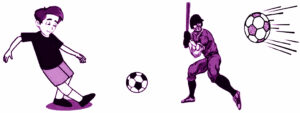
(a) The more force one exerts on the downward bounce, the higher the ball bounces into the air. Which law is this statement being referred to?
Ans. Third law of motion — Action reaction
(b) Among the above given pictures, Newton’s 3rd law is depicted in ________.
Ans. 1st picture
(c) Newton’s second law is also known as __________.
Ans. Law of acceleration
(d) The study of human body and various forces acting on it is _________.
Ans. Kinesiology
Or
A high jumper can jump higher off a solid surface because it opposes his or her body with as much force as he or she is able to generate. This example refers to which law of motion?
Ans. Third law of motion — Action reaction
8.4 Friction & Sports
Multiple Choice Questions
The friction force acts in a/an __________ direction to the direction of motion of an object. (CBSE TBQ)
(a) opposite
(b) same
(c) downwards
(d) diagonal
Among the following sports, in which does friction plays the least important role? (CBSE TBQ)
(a) Car race
(b) Football
(c) Hockey
(d) Ice-skating
Friction is a : (CBSE TBQ)
(a) Magnetic force
(b) Non-contact force
(c) Contact force
(d) Couple force
Cyclist often wears streamlined helmets and specially designed clothing to reduce calibration (CBSE TBQ)
(a) Fluid friction
(b) Rolling friction
(c) Sliding friction
(d) None of the above
The force of friction depends upon (8.4) (CBSE TBQ)
(a) Nature of surface of contact
(b) Material of objects in contact
(c) Both (a) and (b)
(d) None of the above
The force which opposes the relative motion between the surfaces of two objects is known as : (8.4) (CBSE 2020, Comptt.)
(a) Frictional force
(b) Gravitational force
(c) Applied force
(d) Mechanical force
Gliding movement occurs at which joint? (8.4) (SQP Term-I, 2021-22)
(a) Knee
(b) Hip
(c) Wrist
(d) Elbow
Very Short Answer Type Questions (1 Mark)
Why does the weightlifter’s diet include lots of proteins ? (8.4) (CBSE 2018, Delhi)
Ans. • Proteins helps in forming new tissues and repairing the broken tissues.
• To maintain strong ligaments and tendons needed for muscle growth. (Any one)
Define friction and name its types. (8.4) (CBSE 2017)
Ans. The force that develops at the surfaces of contact of two bodies and opposes their relative motion is called friction. Its types are : Static friction and Dynamic friction.
Explain, what is ‘Dynamic Friction’ ? (8.4) (CBSE 2016, Outside)
Ans. Dynamic friction is the force of friction which come into play when a body moves over the surface of another body.
(1) Sliding friction
(2) Rolling friction
Elucidate kinetic energy. (8.4) (CBSE 2017, Comptt.)
Ans. Kinetic energy is the energy possessed by an object due to its motion. The amount of kinetic energy an object has depends on its mass and its velocity.
Short Answer Type-I Questions (2/3 Marks)
Define friction. (CBSE TBQ)
Ans. Friction :
- Friction is the force that opposes the motion of objects traveling through a fluid (such as gas, air, or water) or the force that prevents the motion of stationary objects.
- It can be categorized into different types, such as static friction, kinetic friction, sliding friction, and rolling friction.
- Friction can be advantageous or disadvantageous depending on the context and can affect performance in sports and activities.
What is air resistance ? (CBSE TBQ)
Ans. Air Resistance :
- Air resistance is the force that opposes the motion of an object as it moves through the air.
- It is caused by the collision of air molecules with the surface of the object.
- Air resistance increases with factors such as the surface area of the object, the speed at which it is moving, and the roughness of the object’s surface.
- It can affect the trajectory and speed of a projectile or the movement of an object through the air.
What do you mean by ‘friction is a necessary evil’ ? (CBSE TBQ)
Ans.
- The phrase ‘friction is a necessary evil’ means that while friction can have disadvantages and create difficulties in certain situations, it is also essential and beneficial in many aspects of life, including sports.
- Friction is necessary for various sports activities as it allows athletes to grip equipment, generate ground reaction force, change direction, and maintain control of movement.
- Without friction, athletes would struggle to perform effectively.
- So, while friction may have some negative aspects, it is necessary for optimal performance in sports.
Friction is categorised into how many types? Explain them in brief. (8.4) (SQP 2019-20)
Ans. Friction : Force that is at the surface of contact of two bodies and apposes their relative motion.
(a) Static friction : Body moves on surface of other body but actual motion have not started.
(b) Dynamic friction : Body moves on the surface of other body.
(i) Sliding (ii) Rolling
Short Answer Type-II Questions (4 Marks)
Discuss various types of friction. (CBSE TBQ)
Ans. The different types of friction are :
- Static friction : This occurs when the force applied to an object does not cause it to move. It requires extra force to start the motion of stationary objects.
- Sliding friction : This occurs when two bodies are in contact and one body moves on the surface of the other body by sliding or rubbing over it.
- Rolling friction : This occurs between wheels and a surface. It occurs when one body rolls over another.
- Fluid friction : This occurs when objects travel through a fluid, such as air or water.
- Limiting friction : This is the force that comes into play when one body is just on the verge of moving over the surface of another body. It occurs when the moving force and the force opposing the motion are equal.
Is friction advantageous or disadvantageous in games and sports ? (CBSE TBQ)
Ans. Friction can be both advantageous and disadvantageous in games and sports.
Advantages of friction in games and sports include :
- Better grip : Friction allows athletes to grip sports equipment effectively, such as shoes with spikes in athletics or rackets in badminton.
- Control of movement : Friction between shoes and the court in basketball or between tires and the surface in cycling helps players maintain control of their movement.
- Performance enhancement : Friction is necessary for actions like running, changing direction, and maintaining position on the ground in sports like football and gymnastics.
Disadvantages of friction in games and sports include :
- Heat generation : Friction between tires and the ground during cycle racing can cause tires to heat up, potentially leading to accidents if they burst.
- Skin damage : Friction can damage the skin on the palms of weightlifters and gymnasts, leading to slipping during lifts.
- Difficulty in movement : Excess friction can make movement more difficult, requiring more force and energy to overcome it.
- Injuries : Friction can cause injuries if a player slides or falls across the ground.
Write down the methods of reducing friction and explain any two with suitable example. (CBSE TBQ)
Ans. Some methods of reducing friction in games and sports include polishing, lubricating, and using wheels and ball bearings.
- Polishing involves rubbing and smoothing the surface to reduce its unevenness, which in turn reduces the force of friction. For example, shining a cricket ball increases its swing.
- Using wheels and ball bearings can also help reduce friction. By converting sliding friction into rolling friction, the friction between two contact surfaces is reduced. This saves energy and time. An example of this is seen in roller skates, where both wheels and balls contribute to reducing friction.
Long Answer Type Questions (5 Marks)
What are the various types of friction ? How is friction advantageous or disadvantageous in the field of games and sports ? Explain with suitable examples. (8.4) (CBSE 2017, Outside)
Ans. Types of friction :
- Static friction
- Dynamic friction : (a) Sliding friction, and (b) Rolling friction
Friction : Advantageous or disadvantageous with example.
Friction is usually called a necessary evil. It means that it is essential in games and sports. Without friction we cannot give a better performance for example athletes use spikes and football players use studs to have appropriate friction, without friction they are unable to run fast. Even gymnasts use lime powder on their palms to perform on horizontal bar, uneven bar and roman rings. On the other hand friction is disadvantageous in some games. In cycling there should not be more friction between road and the tyres of the cycle. If there is more friction there will be more wastage of energy of the rider and leads to damage of equipments.
What do you mean by the term Energy ? Discuss about kinetic and potential energy with suitable example from sports. (8.4) (CBSE 2016)
Ans. Energy is the capacity to do work.
Kinetic energy : The energy an object has because of its motion is called K.E.
- The kinetic energy of a moving object depends on its speed e.g., If a Javelin travels with maximum speed then it has more K.E. and when touch the ground, it has no K.E.
- The kinetic energy also depends on the mass of the objects e.g., if a shot of 16 lbs and a shot of 8 lbs travel at the same speed, the 16 lbs shot has more K.E. than the 8 lbs shot.
Potential energy : P.E. is the energy stored in an object because of its position or condition. In Archery, when you stretch a bow; it acquires the ability of releasing an arrow with speed. It means that the stretched bow also has P.E. The more it is stretched, the greater the speed with which it can release the arrow. It has the P.E. because of its stretched condition.
Define trajectory ? Discuss in detail the factors that affect trajectory ? (8.4) (SQP 2015-16)
Ans. Trajectory refers to the path followed by an object in motion, such as a projectile, as it moves through space.
The factors that affect trajectory are :
- Gravity : Gravity is the force exerted by the Earth on an object, pulling it towards the center of the Earth. It affects the vertical component of the trajectory.
- Air resistance : Air resistance is the force exerted by the air on an object moving through it. It affects the horizontal and vertical components of the trajectory. Factors such as surface area, speed, and surface roughness of the object can influence air resistance.
- Speed of release : The initial speed at which an object is released affects its trajectory. A higher release speed can result in a longer and flatter trajectory.
- Angle of release : The angle at which an object is released affects its trajectory. Different angles can result in different distances and heights of the trajectory.
- Height of release : The height from which an object is released affects its trajectory. A higher release height can result in a longer and higher trajectory.
- Spin : The spin applied to an object can affect its trajectory. For example, in baseball, the spin applied to a pitched ball can cause it to curve or break in a certain direction.
Case Study Questions (4 Marks)
1. METHODS OF REDUCING FRICTION : Polishing : If we polish and rub the surface to reduce its unevenness and make it smooth, the force of friction can be reduced. eg., shining a cricket ball increase the swing of the ball.
Lubricating : A common way to reduce the force of friction is by applying a lubricate such as Motor oil, grease, wax etc. eg., the most widely used lubricants in practical mechanical systems like bearings or gears.
Wheels and Ball bearing use : It is easier to roll an object than to slide it by using wheels and ball bearings as we convert sliding friction into rolling friction. This reduces friction between the two contact surfaces and helps us to save energy and time. eg., in roller skates, both wheels and balls contribute to reducing friction.
Streamlining : Friction due to air is reduced by streamlining the shape of the body. eg., the Javelin, boats, ships, and vehicles, are made with a sharp point to reduce friction
What
)
Ans. –
2. Friction is a force that opposes the motion between two surfaces that are in touch. Friction always works in the direction opposite from the direction the object is moving or trying to move. Friction also produces heat. For example, if you rub your hands together quickly, they get warmer. We can also say that frictional force is a contact force that acts in the opposite direction to the motion of an object. This force can cause objects in motion to come to rest, as they act in the opposite direction to their motion. For example, if you roll a ball on a surface, it would come to rest after a short while.
What
)
Ans. –
3. Kinetic friction : It occurs when force is applied to an object and the object moves. It includes different types of friction :
(a) Sliding friction : Pushing an object across a surface. This is when two bodies are in contact and one body moves on the surface of the other body by sliding on it or rubbing over the surface. Example – skating on ice, planting a pole in the pole vault event and skiing or sliding weight.
(b) Rolling friction : It occurs between wheels and a surface. When two bodies are in contact and one body rolls over the other, it is referred to as rolling friction. eg., when a hockey or cricket ball is hit it begins to move ahead and roll on the ground. After sometimes it stops rolling due to the friction force, this type of friction is often seen in sports. eg., Roller skates and skateboards
What
)
Ans. –
8.5 Projectile in Sports
Multiple Choice Questions
Factors that bring air resistance into play (CBSE TBQ)
(a) Larger the surface area
(b) Rough surface
(c) Smaller the mass
(d) All of the above
The motion of a projectile is due to two separates simultaneously occurring components of motion and they are (CBSE TBQ)
(a) One along the vertical
(b) One along the horizontal
(c) Both (a) and (b)
(d) None of above
According to Professor John Fontanella, the ideal angles from the freethrow line will vary from _________ to ________ with shorter players. (CBSE TBQ)
(a) 48.7 degrees to 52.2 degrees
(b) 45.6 degrees and 50.2 degrees
(c) No specific degree
(d) Any degree
Very Short Answer Type Questions (1 Mark)
An object thrown into the space either horizontally or at an acute angle under the action of gravity is called a projectile. Name the two forces which act on a projectile. (8.5) (CBSE 2017, Outside)
Ans. (i) Gravitational force, (ii) Air resistance, (iii) Initial velocity, (iv) Spin.
What is projectile ? (8.5) (CBSE 2018, Comptt.)
Ans. A projectile is an object upon which the only force acting is gravity.
Short Answer Type-I Questions (2/3 Marks)
Define projectile. (CBSE TBQ)
Ans. Projectile :
- A projectile is an object that is only influenced by the force of gravity.
- It can be an object that is dropped from rest, thrown vertically upward, or thrown upward at an angle to the horizontal.
- Examples of projectiles in sports include basketballs, footballs, shot-puts, and javelins.
What is air resistance? List any four factors. (CBSE TBQ)
Ans. Air resistance refers to the force exerted by the air on an object as it moves through the air. Four factors are :
- Surface area : The larger the surface area of an object, the more air resistance it will experience.
- Speed : As the speed of an object increases, the air resistance it experiences also increases.
- Surface of the object : If the surface of an object is rough, it will experience greater air resistance compared to a smooth surface.
- Shape : The shape of an object can affect the amount of air resistance it experiences.
Explain the various factors affecting projectile trajectory. (8.5) (CBSE 2019)
Ans. The various factors that affect projectile trajectory are :
- Gravity : Gravity is the force exerted by the earth on any object towards the center of the body.
- Air resistance: Air resistance is the force exerted by the air on a moving object.
- Speed of release : The speed at which the projectile is released or thrown affects its trajectory.
- Angle of release : The angle at which the projectile is released or thrown into the air affects its trajectory.
- Height of release : The height from which the projectile is released affects its trajectory.
- Spin : Spin refers to the rotation of the projectile as it moves through the air.
What do you mean by Projectile ? Discuss about the factors affecting Projectile Trajectory ? (8.5) (CBSE 2019, Delhi)
Ans. Projectile : An object thrown into the space either horizontally or at an acute angle under the action of gravity is called a projectile.
Factors affecting projectile trajectory : • Initial velocity • Height of projection • Angle of projection • Air resistance • Spin • Gravitational pull • Height of projecting and landing surface
- Air Resistance : Air resistance is another crucial factor that affects projectile trajectory. It is influenced by factors such as the surface area of the object, the speed at which it is moving, and the surface of the object. Objects with larger surface areas experience more air resistance, while smoother surfaces reduce air resistance.
- Spin : Spin is a factor that affects the trajectory of certain projectiles, such as baseballs or golf balls. The spin applied to the object can cause it to curve or change direction during flight.
What is projectile ? Explain any three factors that affect a projectile trajectory. (8.5) (CBSE 2017)
Ans. An object thrown into the air at any angle against the action of gravity is called projectile.
Three factors affecting projectile trajectory :
- Gravity : Gravity is the force exerted by the Earth on any object towards its center. It plays a significant role in determining the trajectory of a projectile. Without gravity, the object would travel in a straight line after being thrown.
- Speed of Release : The speed at which a projectile is released also affects its trajectory. As the speed increases, the projectile covers a greater distance and experiences more air resistance.
- Height of Release : The height from which a projectile is released also affects its trajectory. A higher release point can result in a longer flight path, while a lower release point may result in a shorter flight path.
What are the factors affecting projectile trajectory ? (8.5) (CBSE 2019, Comptt.)
Ans. The key factors that affect the trajectory of a projectile are :
- Gravity : Gravity is the force exerted by the Earth on the projectile, pulling it towards the center of the Earth.
- Air Resistance : It depends on factors such as the surface area, speed, and surface of the projectile.
- Speed of Release : The speed at which the projectile is released or thrown affects its trajectory.
- Angle of Release : The angle at which the projectile is released or launched into the air affects its trajectory.
- Height of Release : The height from which the projectile is released also affects its trajectory.
- Spin : Spin refers to the rotation of the projectile as it moves through the air.
Short Answer Type-II Question (4 Marks)
With suitable example explain different types of projectiles in sports. (CBSE TBQ)
Ans. Some examples of different types of projectiles in sports :
- Basketball : The shape and size of the basketball, along with the force applied by the player, determine the distance and accuracy of the shot.
- Golf Ball : When a golfer hits the ball with a club, it follows a parabolic path in the air. The dimples on the surface of the golf ball help in reducing air resistance and increasing the distance it can travel.
- Javelin : The javelin used in track and field events is a projectile that is thrown by athletes. The javelin follows a curved path in the air, and the distance it can travel depends on factors such as the angle of release, speed of release, and height of release.
- Tennis Ball : In tennis, the tennis ball is a projectile that is hit by players using a racket. The ball follows a trajectory determined by the angle and speed of the racket swing.
- Soccer Ball : The soccer ball is a projectile that is kicked by players during a game. The size and weight of the soccer ball, along with the force applied by the player, determine the distance and accuracy of the kick.
Discuss various factors affecting projectile motion. (CBSE TBQ)
Ans. Some factors that can affect the motion of projectiles in sports are:
- Gravity : Gravity is the force exerted by the earth on any object towards the center of the body. It affects the trajectory and flight path of the projectile.
- Air resistance : Air resistance is the force exerted by the air on the projectile as it moves through the air. Factors such as surface area, speed, surface of the object, and mass can affect the amount of air resistance.
- Speed of release : The speed at which the projectile is released (thrown or hit) can affect its trajectory and distance traveled.
- Angle of release : The angle at which the projectile is released into the air can affect its trajectory. Different sports require different angles of release for optimal performance.
- Height of release : The height from which the projectile is released can affect its horizontal distance. Increasing the height of release can result in greater distance traveled.
- Spin : Spin can be applied to a projectile, such as a ball, and it can affect its trajectory and direction. Spin can be imparted by applying force to the projectile in different ways.
Is projectile advantageous in games and sports? Justify. (CBSE TBQ)
Ans. The advantages of using projectiles in games and sports include:
- Increased distance : By using projectile motion, players can maximize the distance a ball or object can travel. This is important in sports like baseball, where pitchers aim to throw the ball as far as possible, or in golf, where players try to hit the ball long distances.
- Optimal trajectory : Projectile motion allows players to determine the optimal angle at which to release or hit a ball in order to achieve the desired outcome. This is crucial in sports like basketball, where players need to shoot the ball at a specific angle to score.
- Control and accuracy : Understanding projectile motion helps players have better control and accuracy over their shots. By considering factors like speed of release, angle of release, and height of release, players can adjust their technique to achieve the desired outcome.
- Strategic advantage : Knowing how to use projectiles effectively can give players a strategic advantage over their opponents. By understanding the principles of projectile motion, players can anticipate the trajectory of a ball and position themselves accordingly to make successful plays.
- Improved performance : By applying the principles of projectile motion, players can optimize their performance and achieve better results. This can lead to higher scores, longer distances, and improved overall gameplay.
Long Answer Type Questions (5 Marks)
What is Projectile ? Explain the factors affecting projectile trajectory, with suitable examples. (8.5) (CBSE 2017, Comptt.)
Ans. Projectile : A projectile is an object upon which the only force acting is gravity.
Some examples of factors that can affect the trajectory of a projectile in sports are :
- Gravity : Gravity is the force exerted by the earth on any object towards the center of the body. It affects the trajectory of a projectile by pulling it downward.
- Air resistance : The resistance offered by the air affects the trajectory of a projectile. Factors such as surface area, speed, surface of the object, and mass can influence the impact of air resistance.
- Speed of release : The speed at which the object is released or thrown affects its trajectory. A greater release speed can result in a greater distance covered.
- Angle of release : The angle at which the object is released or projected into the air affects its trajectory. Different sports require different angles of release for optimal performance.
- Height of release : The height from which the object is released affects its trajectory. Increasing the height of release can improve the horizontal distance covered by the projectile.
- Spin : The spin applied to a projectile can affect its trajectory. Spin can help maintain the course of the projectile and cause it to change height or direction.
Define projectile and explain any two factors affecting projectile with help of examples from sports. (8.5) (SQP 2022-23)
Ans. Projectile : A projectile is an object that is launched or thrown into the air and moves under the influence of gravity. It continues in motion by its own inertia and is only affected by the downward force of gravity.
Two factors that affect the trajectory of a projectile in sports are :
- Angle of release : The angle at which the object is thrown or hit into the air. Different sports require different angles of release for optimal performance. For example, in basketball shooting, a higher angle above 45 degrees is required for successful shots. In tennis, a lower angle of around 3-to-15 degrees is needed for effective shots.
- Speed of release : The speed at which the object is released or thrown. The greater the release speed, the greater the distance the projectile can travel. For example, in throwing events like javelin or discus, the speed of release plays a crucial role in determining the distance achieved.
These factors, along with other factors like gravity, air resistance, height of release, and spin, all contribute to the trajectory and flight path of a projectile in sports.
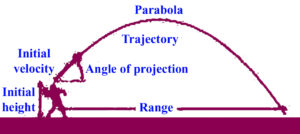
Case Study Questions (4 Marks)
1. Defining Projectiles : A projectile is an object upon which the only force acting is gravity. There are a variety of examples of projectiles. An object dropped from rest is a projectile (provided that the influence of air resistance is negligible). An object that is thrown vertically upward is also a projectile (provided that the influence of air resistance is negligible). And an object which is thrown upward at an angle to the horizontal is also a projectile (provided that the influence of air resistance is negligible). A projectile is any object that once projected or dropped continues in motion by its own inertia and is influenced only by the downward force of gravity. In simple words, an object in flight after being thrown a project is called projectile motion.
What
)
Ans. –
2. Baseball : Pitching analysis : Projectile motion is applicable in both throwing and hitting. A thrown ball undergoes projectile motion when it is mid-air since the only force that affects the ball is the acceleration due to gravity. A variety of factors will go into the trajectory of a pitch, including a pitcher’s height, arm angle, and the spin being applied to the ball.
Hitting analysis : In terms of hitting, advanced analytics like to use “launch angle” as a good indicator of the optimal angle that a ball should be hit. Launch angle is the angle at which a ball exits the bat as soon as they connect with each other. The best launch angles, which allow for line drives and home runs, are calculated to be around 10–30 degrees North of East, relative to the bat. This allows for the most optimal ball flight, usually necessary to hit the ball over 325 to 400 feet over the fence
What
)
Ans. –
3. There are four main types of spin used in sports : Top Spin is where you hit over the ball. Topspin creates a downward force on the ball, causing the ball to drop, Back Spin this is where you hit under the ball, Backspin creates an upward force that lifts the ball, causing the ball to rise, Clockwise Spin this is we are you hit the ball on the left side of the centre of gravity. It causes the ball to swing to the right and Anticlockwise this is where you hit the ball on the right side to the centre of gravity. It causes the ball to swing to the left.
What
)
Ans. –
4.
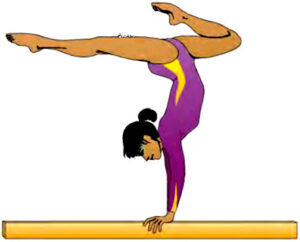
During her gymnastics practice, Zoya was finding it difficult to maintain her balance on the balancing beam. Her coach tried to explain to her about basic principles of equilibrium.
According to the principles of equilibrium centre of gravity plays a very important role. (CBSE TBQ)
(a) __________ C.G. helps in increasing stability.
Ans. (Center of gravity)
(b) __________ base more stability.
Ans. –
(c) There are two types of equilibrium namely _________ and __________.
Ans. –
5.
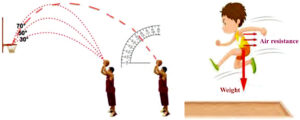
While explaining how to release basketball at a correct angle to successfully score points the basketball coach showed students this picture.
Basketball players wanted to know more about projectiles therefore the coach explained to them the factors affecting flight of an object. (CBSE TBQ)
(a) An object covers less distance when the projected path is at _________ degrees.
Ans. –
(b) If the initial velocity is low the object will cover __________ distance.
Ans. –
(c) If the weight of the object is more the impact of gravity will be __________.
Ans. –